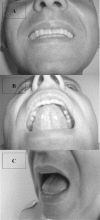The acute effect of the tongue position in the mouth on knee isokinetic test performance: a highly surprising pilot study
- PMID: 24596696
- PMCID: PMC3940506
The acute effect of the tongue position in the mouth on knee isokinetic test performance: a highly surprising pilot study
Abstract
The tongue involvement within the isokinetic knee extension/flexion exercises has been investigated. Eighteen participants randomly underwent isokinetic testing at 90 and 180°/s with three different tongue positions: middle position (MID, thrusting on the lingual surface of incisive teeth), lying on the lower arch of the mouth (LOW) and extended up to the palatine spot (UP). Statistical analysis of the data revealed an about 30% significant increase of knee flexion peak torque in UP with respect to MID at both angular speeds. Such a difference could have had a confounding effect on results from numerous past studies using isokinetic knee flexion testing. This study alerts future researchers about standardization of tongue position and warrants further investigations on the explicative processes of this phenomenon.
Keywords: CNS path; isokinetic test; knee flexion; maximum peak torque; tongue position.
Figures


References
-
- di Vico R, Ferrante A. Valutazione funzionale isocinetica con e senza lingua allo “spot palatino” in un gruppo di atleti a livello agonistico sani. 2009. Master Thesis.
-
- Halata Z, Baumann KI. Sensory nerve endings in the hard palate and papilla incisiva of the rhesus monkey. Anat Embryol (Berl) 1999;199(5):427–437. - PubMed
-
- Martin RE, MacIntosh BJ, Smith RC, et al. Cerebral areas processing swallowing and tongue movement are overlapping but distinct: a functional magnetic resonance imaging study. J Neurophysiol. 2004;92(4):2428–2443. - PubMed
-
- Prodoehl J, Gottlieb GL, Corcos DM. The neural control of single degree-of-freedom elbow movements. Effect of starting joint position. Exp Brain Res. 2003;153(1):7–15. - PubMed
-
- Kothari M, Svensson P, Jensen J, et al. Training-induced cortical plasticity compared between three tongue-training paradigms. Neuroscience. 2013;246:1–12. - PubMed
